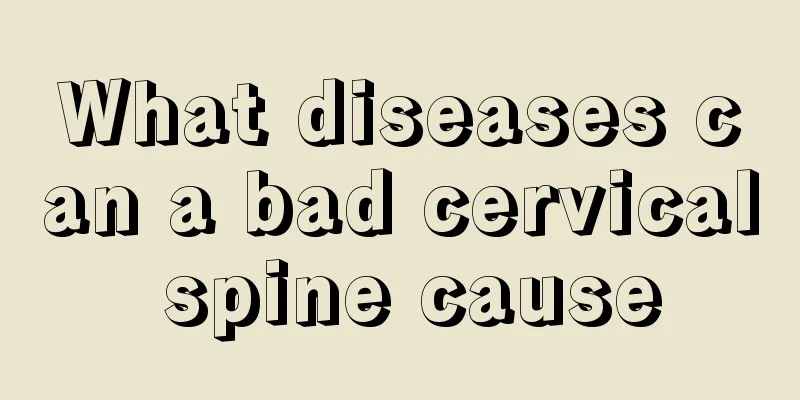What diseases can a bad cervical spine cause

|
A bad cervical spine usually causes gastrointestinal and abdominal bloating problems, followed by nerve reactions, so when there is a problem with the cervical spine, we should correct it in time. Patients with cervical spondylosis should do some appropriate exercises and adjust their sitting posture in their daily life, which will help relieve cervical spondylosis. As for the possible complications caused by cervical spine problems, you can refer to the article for analysis of related complications. 1. Cervical spondylosis can cause dysphagia The upper end of the esophagus is adjacent to the sixth cervical vertebra. Hyperplasia of the sixth cervical vertebra will compress and irritate the esophagus, and even cause inflammation and edema around the esophagus, thereby producing a foreign body sensation when eating. 2. Cervical spondylosis can cause abdominal distension and constipation Some patients with cervical spondylosis have their nearby cervical sympathetic nerves stimulated and damaged, and the sensations are transmitted to the brain, increasing the excitability of the relevant nerves and slowing down the gastrointestinal motility of the internal organs controlled by them, thus leading to abdominal distension and constipation. Cervical spondylosis causes heart discomfort, which is mainly caused by the stimulation of the fourth nerve root by cervical bone hyperplasia, which is related to the sudden change in the position of the neck. 4. Cervical spondylosis can cause partial paralysis of the spinal cord type or a mixture of other types of cervical spondylosis with the spinal cord type as the main type. Since it cannot be treated systematically and well, the pathogenic factors cannot be eliminated. With the progression of the disease, irreversible pathological changes such as spinal cord degeneration and liquefaction occur, and paralysis is inevitable. 5. Cervical spondylosis can cause hypertension. Hypertension caused by cervical spondylosis is called "cervical hypertension". The carotid sinus is located in front of the transverse process of the neck and in the middle and lower cervical vertebrae. When the transverse process of the neck is dislocated, the muscles in front of the transverse process are tense or the transverse process is bonyly displaced, or the uncovertebral joint is dislocated, causing tension in the scalene muscles and fascia, all of which can stretch and stimulate the carotid sinus and cause pressure fluctuations. A sudden increase in blood pressure is common, and sometimes it may be lower than normal. Most patients experience dizziness or vertigo, stiff neck, and heaviness and discomfort in the shoulders and back. If multiple cervical joints are dislocated, it may be accompanied by chest tightness, shortness of breath or arrhythmia. The superior cervical sympathetic ganglion is attached to the transverse cervical process or in front of the transverse cervical process. Dislocation of the transverse process due to cervical dislocation or aseptic inflammation caused by cervical dislocation injury can lead to excitement of the sympathetic postganglionic fibers and cause cerebral vasospasm. If this stimulation persists, it will secondarily affect the function of the cerebral vasomotor center and develop into spasm of small arteries throughout the body, causing blood pressure to continue to rise. Most patients often suffer from headaches, dizziness, insomnia, memory loss, or general fatigue, lethargy, palpitations, chest tightness, tinnitus, blurred vision, and irritability. 6. Cervical spondylosis can cause stomach discomfort Patients with cervical spondylosis, especially those with sympathetic and spinal cord cervical spondylosis, will have symptoms of gastric discomfort such as nausea, heartburn, fullness, belching, vomiting, loss of appetite, noise in the stomach, and loss of appetite. This is mainly due to the clinical manifestations that occur due to the reflex of the sympathetic nerves when tissues such as the dura mater of the cervical spinal cord are compressed and stimulated. The degenerative and unstable cervical vertebrae are dislocated, affecting the vertebral artery and causing ischemia of the basilar artery. This causes ischemia of the medulla oblongata and leads to nausea (the vomiting center is located on the back of the lateral reticular structure of the medulla oblongata) and dizziness. If the transverse processes of the cervix 3 to 5 are dislocated and damage the phrenic nerve, dizziness, nausea, vomiting, and pain and discomfort in the upper limbs will occur. Some experts have observed that dislocation of the transverse processes of the cervical spine 3 to 5, especially lateral dislocation of the uncovertebral joint, can cause hiccups. At the same time, dislocation of the middle and upper cervical vertebrae affects the phrenic nerve and vertebral artery, and can also cause symptoms of autonomic nervous system dysfunction such as upper abdominal fullness, belching, and decreased appetite. 7. Cervical spondylosis can cause limb swelling Swelling refers to the swelling of the limbs; distension is the feeling of distension felt by the patient. Limb swelling may occur in various types of cervical spondylosis. In the early stage of patients with cervical spondylosis, swelling will occur in the neck, shoulders and back. This is due to edema caused by local neuromuscular stimulation by physical or chemical factors. During the attack period of radiculopathy, the neck, shoulders and upper limbs will swell, accompanied by burning pain, which is caused by nerve root edema. Patients with sympathetic cervical spondylosis will experience swelling of the upper limbs. At the beginning, the local skin temperature will drop, and the patient will be afraid of cold and feel itchy when exposed to cold. Then redness and swelling will appear, and the pain will worsen. This is caused by spasm of the blood vessels in the upper limbs. In spinal cord cervical spondylosis, the upper limbs will swell, the skin will become shiny, the movement will be impaired, and even disuse will occur. This is caused by compression of the spinal cord. 8. Cervical spondylosis can cause chest pain There are more and more clinical cases of angina pectoris caused by dysfunction of cervical sympathetic ganglia due to cervical vertebrae dislocation, which stimulates the superior, middle and inferior cervical cardiac branches and causes excitement, leading to arrhythmia and vasospasm, and ultimately causing angina pectoris. 9. Cervical spondylosis can cause stroke It is certain that cervical spondylosis can cause stroke, which is determined by the anatomical, physiological and pathological characteristics of the cervical spine. Under normal circumstances, the head position changes through the movement of the cervical spine. This displacement movement will not cause the vertebral body to be dislocated forward or backward because of the elastic intervertebral disc. As we age, the muscles and ligaments in the neck become strained and degenerate, and the strength and function of the fixed joints weaken. When we lower or raise our head, the neck joints become unstable, swing, and dislocate, which will inevitably stimulate the vertebral artery passing through the foramen of the transverse process of the cervical vertebrae, causing it to spasm, contract or twist, resulting in insufficient blood supply to the brain. In addition, because the fibers of the intervertebral disc are attached to the edge of the vertebral body, dislocation will cause repeated pulling of the annulus fibrosus, irritating the edge of the vertebral body, causing bone hyperplasia, compressing the vertebral artery, causing vertebral artery stenosis or spasm, and also causing insufficient blood supply to the brain. This leads to clinical symptoms such as dizziness, nausea, tinnitus, and blurred vision. Cervical spondylosis often occurs in middle-aged and elderly people, who are often accompanied by cerebral arteriosclerosis, which slows down cerebral blood flow, making it easy to form blood clots and cause stroke. 10. Cervical spondylosis can induce cervical cerebrovascular disease Among the nearly 1 million cerebrovascular patients in the country each year, 26% are caused by cervical spondylosis. This is due to compression of the vertebral basilar artery, which causes insufficient blood supply to the brain. If this condition persists for a long time, dizziness, numbness of the hands and feet, unsteady walking, and even cerebral thrombosis and cerebral infarction may occur. Some patients may suffer from hemiplegia as a result. If cervical spondylosis is treated promptly, it will not deteriorate into serious consequences such as stroke and hemiplegia. |
<<: What tests should be done to see cervical spondylosis
>>: How does cervical vertebrae cause chest pain
Recommend
There is only one trick to deal with the heavy humidity in autumn
Summer has completely left us, and our clothes ha...
What is the reason for the swelling above the incision of thyroid cancer
Swelling above the incision of thyroid cancer pat...
Can sodium bicarbonate be used to wash the vulva?
In fact, sodium bicarbonate is widely used in dai...
What is occupational psychological trauma?
As we all know, no matter what profession it is, ...
What disease is anal bleeding
Anal bleeding is a common problem, and there are ...
Symptoms of tonsillitis
Speaking of tonsillitis, I believe everyone is fa...
What are the factors that contribute to the cost of osteosarcoma?
Having osteosarcoma is undoubtedly a very painful...
Calories of fried dough sticks
Fried dough sticks are a traditional breakfast in...
What are the various diagnostic methods for tongue cancer?
Cancer is a serious disease that endangers human ...
Symptoms of hand synovitis
In fact, synovitis in the hands is quite common, ...
How to clean a newly bought refrigerator
In the past, when living conditions were not very...
Will long-term stomach problems lead to stomach cancer?
Once gastric cancer takes away our health, our pr...
How many days after ovulation does it take for implantation to occur?
The method of calculating the ovulation period is...
How to wash a quilt
If we find that our quilt is dirty, how do we was...
Is anorectal cancer contagious?
Now we all know that some diseases can be transmi...









